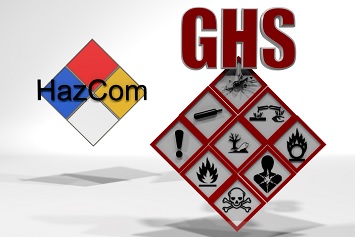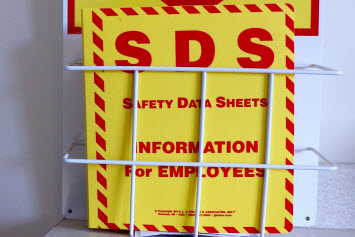Chemical substances can have an assortment of labels and placards as they move through commerce and eventually end up as waste products. The Departments of Labor (DOL) and Transportation (DOT) and the Environmental Protection Agency (EPA) have regulatory authority during various points of transport, storage, use, and disposal of hazardous substances. The National Fire Protection Association (NFPA) also weighs in with its own set of symbols. Representatives from various federal agencies also negotiate with their counterparts in other countries to produce uniform systems of chemical labeling and safety information.
The pieces fit into a framework that has developed over decades:
- The United Nations’ UN Recommendations on the Transport of Dangerous Goods, referred to as the “Orange Book” for its orange cover, is a model regulation of standards for containers, packages, and placards used for hazardous materials (hazmat) transportation;
- Hazmat transportation is regulated by the DOT’s Pipeline and Hazardous Materials Safety Administration (PHMSA) under the Hazardous Materials Transportation Act of 1975 (HMTA);
- The UN’s Globally Harmonized System of Classification and Labelling of Chemicals (GHS), referred to as the “Purple Book” for its purple cover, is a model regulation for chemical testing, hazards classification, and hazard communication;
- The Occupational Safety and Health Administration (OSHA) hazard communication (HazCom) standard (29 CFR 1910.1200) regulates chemical safety in the workplace, incorporating many elements of the GHS;
- Hazardous waste disposal in regulated by EPA under the Resource Conservation and Recovery Act (RCRA); but OSHA also regulates the health and safety of workers through its Hazardous Waste Operations and Emergency Response (HAZWOPER) standard (29 CFR 1910.120); and
- The NFPA developed a standard (NFPA 704) for labeling containers, tanks, and facilities to alert firefighters and other first responders to fire, health, and other hazards.
An NFPA “fire diamond” is separated into blue, red, and yellow quadrants to communicate health, flammability, and instability hazards and a fourth—white quadrant—with special warnings. The white quadrant warns firefighters whether a substance is an asphyxiant gas, oxidizer, or reacts with water. A container sometimes may display a DOT placard, NFPA fire diamond, and OSHA HazCom label simultaneously.
Information about the health, flammability, instability, and special hazards displayed in a fire diamond also should be covered in sections of a safety data sheet (SDS) required by the HazCom standard. However, the systems used to characterize hazards are different. The NFPA rating system in NFPA 704 rates hazards from least hazardous—0 (zero)—to most hazardous—4. The HazCom standard, which conforms to the GHS, ranks hazards from most severe—1—to least severe—4—for use in SDSs.
OSHA Incorporated GHS in 2012
On March 26, 2012, OSHA revised the HazCom standard to harmonize its provisions with the UN’s GHS.
GHS is a model regulation developed by OSHA and regulatory agencies from other countries to ease international trade with a uniform system of product labeling and SDSs.
OSHA’s HazCom standard includes employer requirements for a written HazCom plan, labels on hazardous substances, a collection of SDSs about hazardous substances in the workplace, and information and training for workers about substances they many encounter every day in the workplace.

In March 2012, OSHA stated the revised HazCom standard would improve worker understanding of everyday workplace hazards while reducing employers’ cost of compliance. When OSHA updated its HazCom standard, the rulemaking put changes in place to conform with the third edition of the GHS. UN negotiators just completed and published an eighth edition.
The problem with a U.S. standard that conforms to the third edition and an international agreement now in its eighth edition is that labels and SDSs compliant with a later version of the GHS may be noncompliant with the current HazCom standard. Employers with overseas suppliers or customers may find themselves juggling different standards. OSHA inspectors must determine whether labels and SDSs meet the requirements of the current HazCom standard.
OSHA added a rulemaking to its Fall 2014 regulatory agenda to update the HazCom standard to incorporate changes to the GHS since 2012. In the agency’s Fall 2019 agenda, its most recent, OSHA announced plans to publish a notice of proposed rulemaking (NPRM) in January. OSHA has yet to publish that NPRM.
Updates to the GHS since 2012 include the following:
- A codified system of pictograms for labels,
- New hazard classifications and revisions to the flammable gases hazard category,
- Updated precautionary statements for certain hazards, and
- Revised guidance for authoring labels and SDSs.
OSHA has made no statements about what elements of the updated GHS would be incorporated in a revised HazCom standard.
A Top 10 Violation
OSHA’s HazCom standard also is one of the agency’s most frequently cited standards year after year. Hazard communication was the second most cited violation in fiscal year 2019—violated over 4,000 times—exceeded only by violations of the construction fall protection standard.
Specific violations frequently cited include failing to implement and maintain a written program, provide employee information and training, maintain copies of SDSs for every hazardous chemical in the workplace, ensure each container of a hazardous substance is labeled, and obtain SDSs from chemical manufacturers or develop SDSs for hazardous substances in the workplace.
Steps to establishing a successful HazCom program include:
- Becoming familiar with provisions of OSHA’s standard, designating an employee or supervisor with overall responsibility for hazard communication, and identifying personnel to manage employee training;
- Preparing and maintaining a written program, including a list of all hazardous substances in the workplace;
- Ensuring all containers are properly labeled;
- Maintaining a collection of SDSs for all hazardous substances in the workplace;
- Training employees on hazardous substances in the workplace and substances introduced into the workplace; and
- Evaluating and assessing the program and making any necessary updates to elements of the HazCom program.
Compliance with the HazCom standard is not “one and done” but an ongoing responsibility. Familiarize yourself with the scope and application of the standard, as well as its definitions.
The written HazCom program helps ensure compliance with all the other elements of the standard. A written program needs to cover how you will handle labels and other warnings, SDSs, and employee information and training. The written program must include a list of all hazardous substances in the workplace. Chemicals in the workplace include liquids in containers but also include gases; vapors, fumes, and mists; as well as solids that may or may not be “contained.”
It may be helpful to list substances by work area in larger facilities. A single, comprehensive list may work best for a small facility.
A written program needs to include methods for informing employees of hazards during nonroutine tasks that may require special precautions, such as using personal protective equipment (PPE). A written program for a multiemployer workplace needs to address how other employers’ employees can access SDSs for substances on-site and how they will be informed of chemical hazards in the workplace and necessary precautions.
Every container of hazardous substances in the workplace must be labeled. The label provides immediate warnings of hazards and instructions about protective measures. The corresponding SDS contains more detailed information.
Chemical manufacturers or importers must label containers, using labels compliant with the HazCom standard. The label must include the following:
- Product identifier, such as the chemical’s common or trade name;
- Signal word like “Danger” or “Warning”;
- Hazard statement, describing the nature and degree of the hazard;
- Pictogram, depicting the product hazard, although some products may have a DOT hazmat pictogram in addition to or instead of a HazCom pictogram;
- Precautionary statement describing actions to take to prevent or minimize the adverse effects of exposure; and
- Name, address, and phone number of the responsible party.
During an OSHA inspection, the Compliance Safety and Health Officer (CSHO) will check for the person assigned responsibility for label compliance in the workplace, appropriate labels on all containers in the workplace, description of alternative labeling methods used for stationary process containers, description and explanation of labels used in or shipped through a workplace, and procedures for reviewing and updating labels.

SDSs use a 16-section format specified in the HazCom standard that conforms to the third edition of the GHS and is based on the American National Standard for Hazardous Workplace Chemicals–Hazard Evaluation and Safety Data Sheet and Precautionary Labeling Preparation (ANSI Z400.1).
The 16 sections of an SDS are:
- Identification,
- Hazard(s) identification,
- Composition/information on ingredients,
- First-aid measures,
- Firefighting measures,
- Accidental release measures,
- Handling and storage,
- Exposure control/personal protection,
- Physical and chemical properties,
- Stability and reactivity,
- Toxicological information,
- Ecological information,
- Disposal considerations,
- Transport information,
- Regulatory information, and
- Other information.
The ecological information, disposal considerations, transport information, and regulatory information sections are nonmandatory. SDSs must be in English. Employers are responsible for requesting corrected SDSs if manufacturers or suppliers ship products with incomplete, insufficient, or missing SDSs.
An OSHA inspector will check for a complete collection of SDSs for all substances in the workplace, the person designated as responsible for SDSs, how SDSs are maintained (electronically or in a notebook) and how employees obtain access to them, procedures used when shipments do not include SDSs, and whether workers are trained in the format and use of SDSs.
Information, Training
All employees must be informed of the requirements of the HazCom standard, where hazardous substances are located in the workplace, and what the written HazCom program includes and how to access and use it.
HazCom training needs to cover:
- Methods used to detect the presence or release of a hazardous chemical in the work area;
- Hazards of chemicals in the workplace, such as physical, health, asphyxiation, combustible dust, and pyrophoric gas hazards, as well as hazards not otherwise classified;
- Measures employees can take to protect themselves from these hazards, including specific procedures the employer has implemented to protect employees from exposure to hazardous chemicals, such as work practices, emergency procedures, and PPE to be used; and
- Details of the HazCom program developed by the employer, including an explanation of the labels on shipped containers received and the workplace labeling system used by their employer; SDSs, including the format of and information contained in an SDS, and how employees can obtain and use the hazard information provided by an SDS.
OSHA inspectors will look for training elements, formats, and procedures, as well as the person assigned responsibility for training. Remember: OSHA issues nearly as many citations for information and training violations as it does for lack of a written program.

